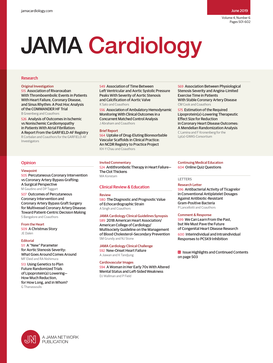Trends in Transcatheter Aortic Valve Replacement Outcomes: Insights From the STS/ACC TVT Registry.
IF 14.8
1区 医学
Q1 CARDIAC & CARDIOVASCULAR SYSTEMS
引用次数: 0
Abstract
Importance Although transcatheter aortic valve replacement (TAVR) outcomes in the US have improved substantially since 2011, it is unknown whether these trends have continued since 2019. Objective To examine changes in risk-adjusted TAVR outcomes from 2019 to 2022 and to examine any noteworthy trends over time. Design, Setting, and Participants This cohort study examined data from patients with severe aortic stenosis treated with TAVR at 786 US hospitals between January 1, 2019, and March 31, 2022, included in the Society of Thoracic Surgeons (STS)/American College of Cardiology (ACC) Transcatheter Valve Therapies (TVT) Registry. Exposure Patients who underwent TAVR. Main Outcomes and Measures The primary outcome was 30-day mortality, and the secondary outcomes were in-hospital mortality and 30-day composite adverse events. To understand factors explaining these trends, a series of logistic regression models was constructed for each outcome, with time as the primary explanatory variable. After adjusting for changing patent characteristics and procedural factors, a series of exploratory analyses was performed to examine the extent to which these findings could be explained by several plausible hypotheses. Results This study's analytic cohort included a total of 210 495 patients. Median (IQR) patient age was 79 (73-85) years, and 91 313 patients (43.4%) were female. Median (IQR) STS predicted risk of mortality (PROM) was 3.3% (2.0%-5.3%). There were no significant changes in unadjusted 30-day mortality from quarter 1 of 2019 (2.4%) to the end of quarter 1 of 2022 (2.2%) (P for trend = .10), with an unadjusted odds ratio (OR) for time of 0.98 per year (95% CI, 0.94-1.01). After adjusting for patient characteristics, the OR increased to 1.05 per year (95% CI, 1.02-1.08), which increased further after adjusting for procedural characteristics to 1.09 per year (95% CI, 1.05-1.13). In exploratory analyses, there were no meaningful changes in the adjusted odds of death after excluding sites that entered the STS/ACC TVT Registry in 2019 or later (OR, 1.09; 95% CI, 1.05-1.13), low-volume sites (OR, 1.09; 95% CI, 1.06-1.13), low-risk patients (OR, 1.11; 95% CI, 1.07-1.15), patients with a bicuspid aortic valve (OR, 1.09; 95% CI, 1.05-1.13), in-hospital deaths (OR, 1.08; 95% CI, 1.03-1.14), or patients who experienced a major vascular complication (OR, 1.09; 95% CI, 1.05-1.12). Conclusions and Relevance In this observational cohort study performing a national analysis of outcomes after TAVR, it was found that risk-adjusted 30-day mortality increased modestly from January 2019 to March 2022. However, no site-level, patient-related, or process-related factors were identified that could explain these findings. Although the absolute increase in risk-adjusted mortality during the study period was relatively small, these findings warrant continued surveillance.经导管主动脉瓣置换术结果的趋势:来自 STS/ACC TVT 注册的启示。
重要性虽然美国的经导管主动脉瓣置换术(TAVR)结果自2011年以来有了大幅改善,但这些趋势自2019年以来是否持续还不得而知。目的研究2019年至2022年风险调整后TAVR结果的变化,并研究随时间推移的任何值得注意的趋势。设计、设置和参与者这项队列研究检查了2019年1月1日至2022年3月31日期间在美国786家医院接受TAVR治疗的重度主动脉瓣狭窄患者的数据,这些患者被纳入了胸外科医师学会(STS)/美国心脏病学会(ACC)经导管瓣膜治疗(TVT)登记处。主要结果和测量指标主要结果是30天死亡率,次要结果是院内死亡率和30天综合不良事件。为了解解释这些趋势的因素,针对每项结果建立了一系列逻辑回归模型,并将时间作为主要解释变量。在对不断变化的专利特征和手术因素进行调整后,进行了一系列探索性分析,以研究这些结果在多大程度上可以用几个看似合理的假设来解释。患者年龄中位数(IQR)为 79(73-85)岁,女性患者为 91 313 人(43.4%)。STS预测死亡风险(PROM)中位数(IQR)为3.3%(2.0%-5.3%)。从 2019 年第 1 季度(2.4%)到 2022 年第 1 季度末(2.2%),未经调整的 30 天死亡率没有明显变化(趋势 P = 0.10),未经调整的时间比(OR)为每年 0.98(95% CI,0.94-1.01)。调整患者特征后,OR 升至每年 1.05(95% CI,1.02-1.08),调整手术特征后,OR 进一步升至每年 1.09(95% CI,1.05-1.13)。在探索性分析中,在排除2019年或之后加入STS/ACC TVT注册的医疗机构(OR,1.09;95% CI,1.05-1.13)、低容量医疗机构(OR,1.09;95% CI,1.06-1.13)、低风险患者(OR,1.11;95% CI,1.07-1.15)、双主动脉瓣患者(OR,1.09;95% CI,1.05-1.13)、院内死亡(OR,1.09;95% CI,1.05-1.13)、主动脉瓣关闭不全(OR,1.09;95% CI,1.07-1.15)、主动脉瓣狭窄(OR,1.09;95% CI,1.07-1.15)、主动脉瓣关闭不全(OR,1.09;95% CI,1.06-1.13)后,调整后的死亡几率没有明显变化。13)、院内死亡(OR,1.08;95% CI,1.03-1.14)或出现主要血管并发症的患者(OR,1.09;95% CI,1.05-1.12)。结论和相关性在这项对 TAVR 术后结果进行全国性分析的观察性队列研究中发现,从 2019 年 1 月到 2022 年 3 月,风险调整后的 30 天死亡率略有增加。但是,没有发现任何可解释这些结果的部位、患者或流程相关因素。虽然研究期间风险调整后死亡率的绝对增长幅度相对较小,但这些结果值得继续监测。
本文章由计算机程序翻译,如有差异,请以英文原文为准。
求助全文
约1分钟内获得全文
求助全文
来源期刊

JAMA cardiology
Medicine-Cardiology and Cardiovascular Medicine
CiteScore
45.80
自引率
1.70%
发文量
264
期刊介绍:
JAMA Cardiology, an international peer-reviewed journal, serves as the premier publication for clinical investigators, clinicians, and trainees in cardiovascular medicine worldwide. As a member of the JAMA Network, it aligns with a consortium of peer-reviewed general medical and specialty publications.
Published online weekly, every Wednesday, and in 12 print/online issues annually, JAMA Cardiology attracts over 4.3 million annual article views and downloads. Research articles become freely accessible online 12 months post-publication without any author fees. Moreover, the online version is readily accessible to institutions in developing countries through the World Health Organization's HINARI program.
Positioned at the intersection of clinical investigation, actionable clinical science, and clinical practice, JAMA Cardiology prioritizes traditional and evolving cardiovascular medicine, alongside evidence-based health policy. It places particular emphasis on health equity, especially when grounded in original science, as a top editorial priority.
 求助内容:
求助内容: 应助结果提醒方式:
应助结果提醒方式:


